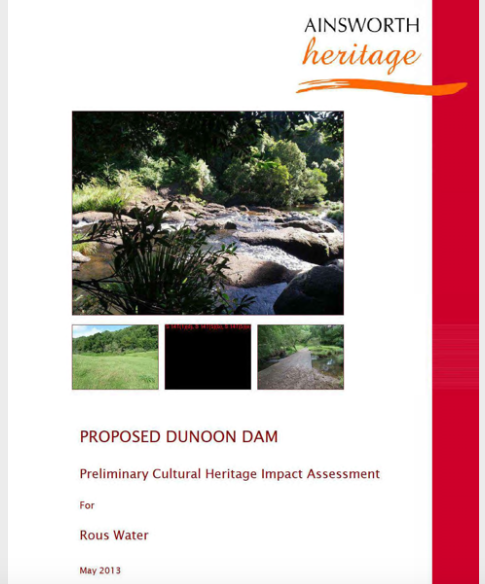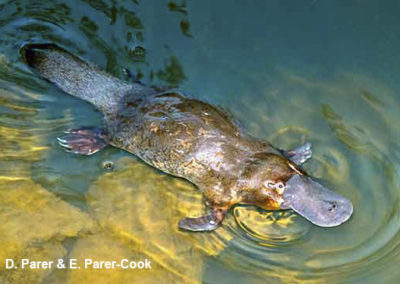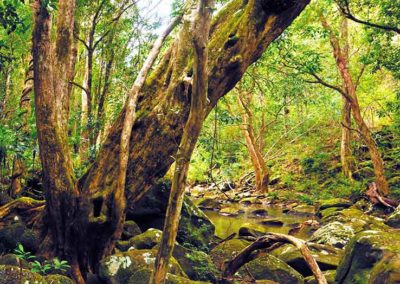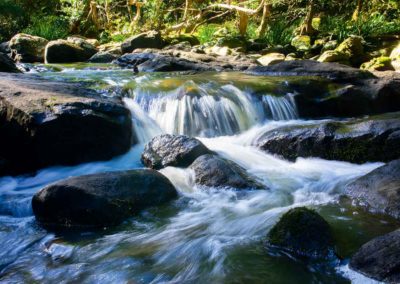Water Supply – Security in Diverse Sources
No Dunoon Dam – Respect & Protect:
Widjabul Wia-bal heritage | Resilient Water Security
Big Scrub rainforest remnant | Koala habitat
WATER Northern Rivers Alliance is a group established in 2020 to advocate for a secure water system for the Northern Rivers region in the face of impending climate change. We have consistently opposed the building of the Dunoon Dam.
Water Security / Dunoon Dam Update: July 2024
A statement from the Widjabul Wia-bal Gurrumbil Aboriginal Corporation – April 2024
“Widjabul Wia-bal Gurrumbil Aboriginal Corporation RNTBC strongly oppose the Dunoon Dam project. Widjabul Wia-bal Gurrumbil Aboriginal Corporation RNTBC do not support Rous County Council engaging Everick Heritage to undertake a further Aboriginal Cultural Heritage Survey of the area. If a further Aboriginal Cultural Heritage Survey is undertaken by Rous County Council, this must be done in direct consultation with Widjabul Wia-bal Gurrumbil Aboriginal Corporation RNTBC and adopt all recommendations made by the RNTBC on behalf of Widjabul Wia-bal.”
Rous ploughing ahead with further ‘dam’ studies
Dec 2023 – Jan 2024. Rous County Council released their tender to proceed with further ecological and cultural heritage studies into the Dunoon Dam site. Consultants Everick and Ecosure have been awarded to do the studies.
Shocking: Tenders specify excavation of burial mounds in further study
This is causing much concern and pain for the Widjabul Wia-bal who have made it explicitly clear they do not want their ancestors’ graves disturbed or flooded. When questioned about this Rous says they will not be excavating within 50m of the burials, which is not what the tender documents specify. Rous has not clarified this discrepancy.
Landholders in dam footprint say No Entry to Rous consultants
May 2024. A number of landholders whose properties would be affected by the Dunoon Dam have refused access to Rous’ consultants for yet more pointless studies of cultural heritage and biodiversity. The landowners are standing in solidarity with the Widjabul Wia-bal mob who have never stopped saying No.
Jan Petroff, landholder in the proposed Dunoon Dam area, refuses access to Rous and their consultants.
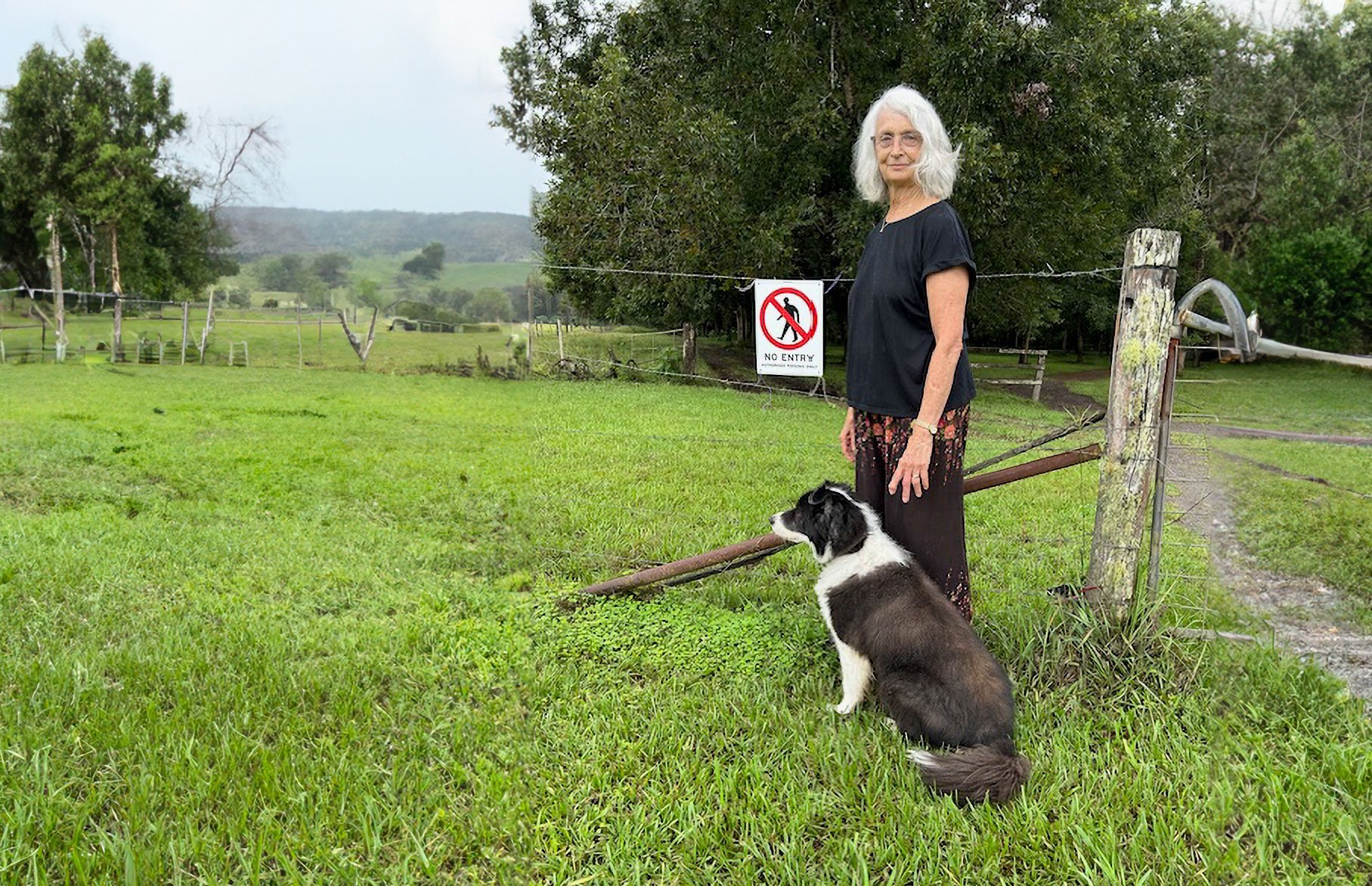
Byron Council jumping the gun in trying to connect Mullum to Rous water permanently
Connecting Mullumbimby to Rous water supply will leave Mullum without their own independent water supply (currently Laverty’s Gap), our region less resilient overall, and will further Rous’ case for the destructive Dunoon Dam. Byron should follow the DPE’s 2023 Far North Coast Regional Water Strategy, not Rous County Council’s plans. The state-sanctioned plans are where finance will be directed.
Byron Shire Council conducted a Have Your Say survey in June 2024 regarding the future of Mullumbimby’s water supply. There were 433 responses to the survey overall: 89% don’t want Mullum to connect to Rous, 5.5% were neutral & 5.5% wanted Mullum to connect to Rous.
Image: Laverty’s Gap Weir – current Mullumbimby water supply (independent from Rous). March 2024
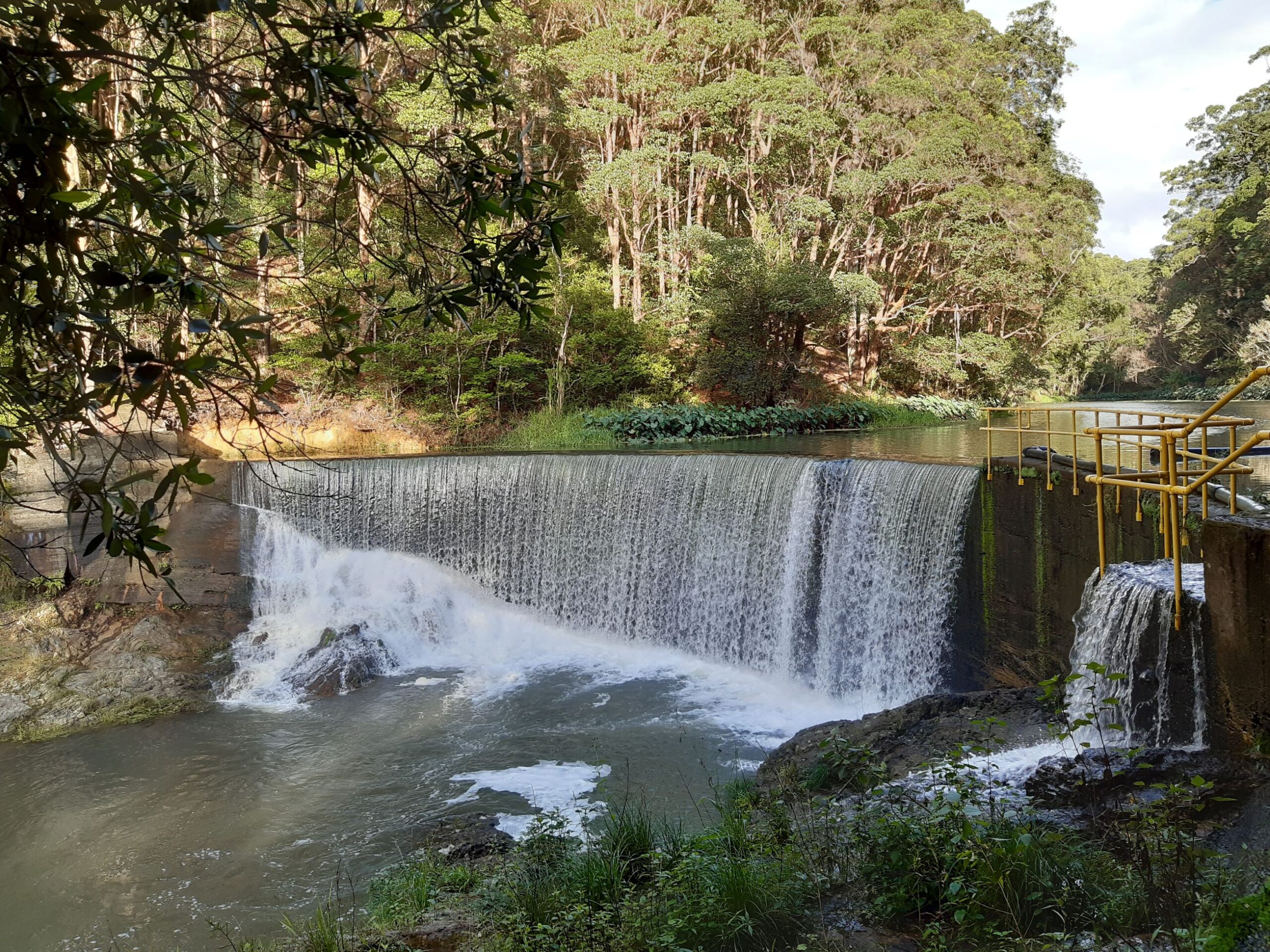


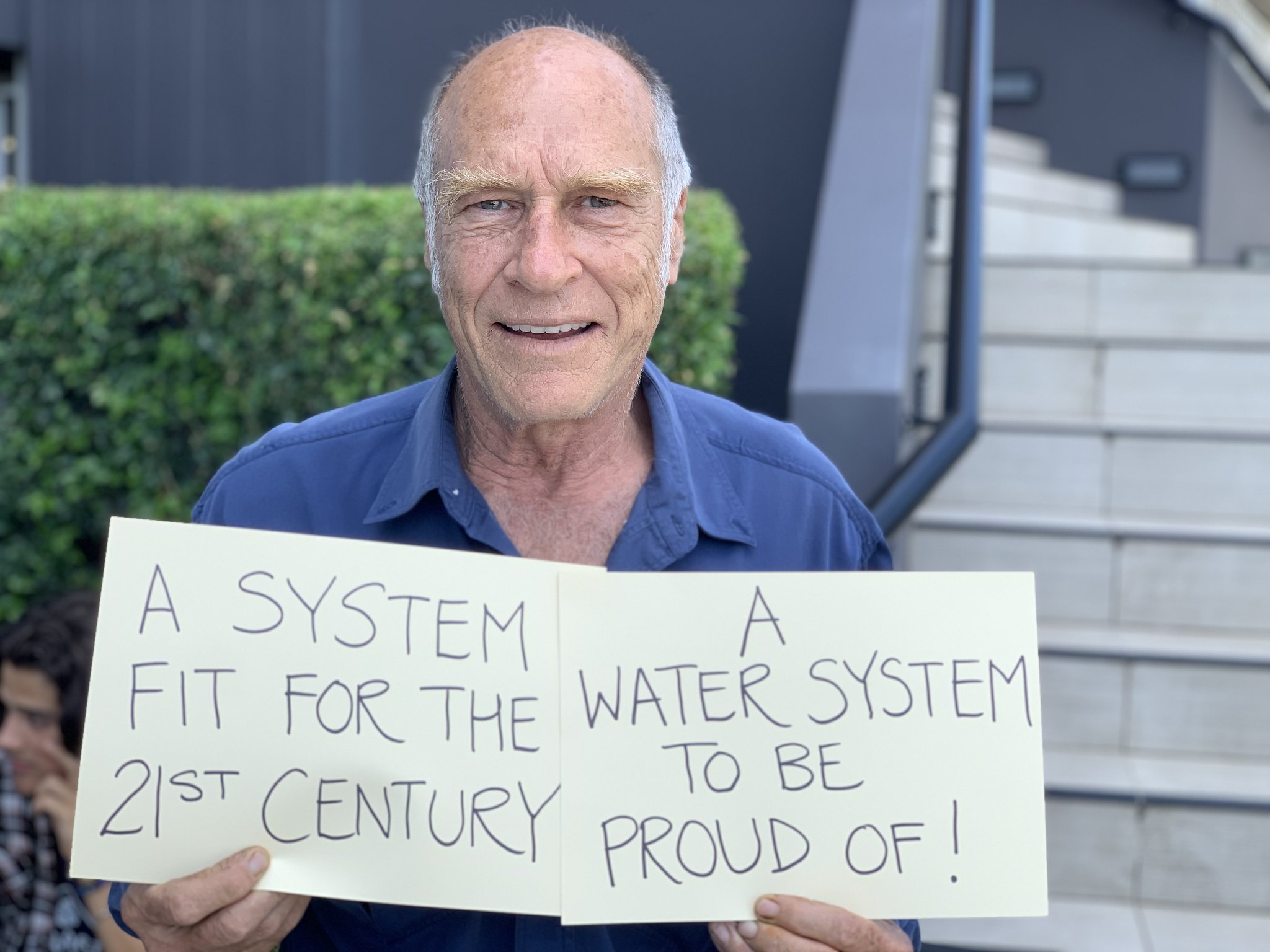
Dunoon Dam Update: December 2023
We have not heard much about the Dunoon Dam lately and many people are asking “What is happening with that dam?”
The short answer is that Rous is definitely planning on building the Dunoon Dam as part of Stage 3 of its Future Water Project.
Six of the eight councillors on Rous are strongly in favour of the dam. They will decide whether it goes ahead. These same six councillors circulated a petition in 2021 which specifically discounted all permanent water supply options other than a new dam. Based on that petition they do not accept recycling (“toilet to tap” as they call it), or groundwater, or desal plants.
Kerb-side push-poll signatures for this petition were collected by asking “do you want to drink toilet water or do you want a new dam?” Rous incorrectly counted 1000’s of these signatures as valid submissions to its public consultation process for its revised Integrated Water Cycle Management Plan in 2021. (This was the plan which excluded the Dunoon Dam). The result was an apparent majority in favour of the dam.
However, all of the other submission processes since 2020 have been overwhelmingly against the dam:
- Rous’ consultation on the Future Water Project in mid-2020: 98% against the dam
- Dept Planning and Environment (DPE) consultation on the Draft Far North Coast Regional Water Strategy in late-2020: 95%against the dam
- DPE consultation on the 2nd Draft Far North Coast Regional Water Strategy in 2022: 97%against the dam
There is clearly a lack of social licence for the dam and a strong social movement against it.
The DPE released the final Far North Coast Regional Water Strategy in June 2023. The dam was not included in the short list of options. They took account of the strong community opposition, the “major to extreme” environmental effects, and the lack of cost effectiveness of the dam.
Nevertheless, the DPE has not precluded Rous and the four LGAs (Lismore, Ballina, Byron and Richmond Valley) from going it alone in their pursuit of the dam. The dam could still be constructed by Rous, despite the evidence that the dam is not viable economically, socially, culturally, environmentally, or in the provision of drought or flood security.
For those who are new to this issue here are some of the reasons why this community and region do not need the Dunoon Dam.

Cost
The original $220 mill cost of the dam is now estimated by DPE at $514 mill, or $841 mill if the service area were extended to include independent water supplies such as Nimbin and Mullumbimby.
Dam construction habitually blows out by 50% so this figure could be expected to rise. This huge upfront cost would place a large financial burden on residents who would be paying water storage costs from day one without any benefit for forty years or more.
With government funding unlikely, it would be financed primarily by current and future water users.
Rous has not provided an estimate of the effect of the dam construction on the price of bulk water to the LGAs. That would be helpful in order to work out what ratepayers would have to pay in extra charges.
For the many people who are already struggling, inflated water rates would be an
additional but unnecessary hardship.

Water security
The proposed 50 GL dam would have 3.5 times the capacity of the 14 GL Rocky Creek Dam upstream but has only half the catchment area. Rocky Creek Dam holds roughly one year’s supply of water. With 4 years of minimal rain and no wet season, both Rocky Creek and Dunoon dams could be empty. A full dam in a flood year is no security for a prolonged drought.
Dams no longer defeat drought, especially when global heating is already making extreme droughts and floods more likely. Droughts more than a decade long have been recorded in the past and will be more likely in the future. The DPE explains the evidence clearly in the Regional Water Strategy.
In a warming climate with increasingly erratic rainfall, water supplies that are rain-dependent are inherently insecure. The high cost and the all-water-in-one-bucket approach of a new dam would impede other water strategies that show a higher cost/benefit ratio, i.e. they would cost a great deal less and provide real benefits.
Water authorities and governments recognise the need to reduce dependence on rainfall; 50% non-rainfall dependent supply is recommended. The region supplied by Rous already has a dam. Now we need the numerous other sources and strategies to be implemented so that we have true water security. Well-funded water efficiencies have been proven repeatedly to be the quickest way to
obtain the most water for the least cost.
Catastrophic events can occur, making a new dam a less safe option that the alternatives. Blue-green algae contamination already occurs at Clarrie Hall Dam and Emigrant Creek Dam. Increased heat and evaporation makes contamination events more likely.
Dam failure is not out of the question. In the 2022 flood, Rocky Creek Dam came so close to over-topping, and hence failing, that downstream residents were warned by text “Dam failure. Evacuate now”. If the earth-wall dam did fail and the released water hit a rolled-concrete wall a few km downstream the results would be unthinkable. Such extreme flooding as we saw in 2022 may well be exceeded in the future.
As for flood mitigation, over 1000 GL of water moved through Lismore in the 2022 flood. A 50 GL dam upstream, even if completely empty at the start of the event, could do very little to reduce that volume. And then, to be ready for the second flood a month later, it would have to be immediately emptied into an already flooded landscape.

Cultural effects
The Widjabul Wia-bal people of the Bundjalung nation have said repeatedly since the dam was first proposed in 1995 that they do not accept it. In 2011, senior knowledge holder Uncle John Roberts, revealed to anthropologists the location of a burial ground and other significant evidence of Aboriginal occupation at the site (2011 Dunoon Dam Cultural Heritage Impact Assessment (CHIA)).
Two years later, this information was confirmed in the 2013 CHIA in which the eminent archaeologist, Dr Douglas Hobbs, stated that the burials were likely to be pre-European.
Rous has decided to impose yet another study on the Widjabul despite their resistance and their determination to follow Uncle John Roberts’ wishes of “No dam, No more studies”.
This site is Australian heritage; we must not lose it.

Environmental effects
The DPE’s Draft Strategy determination that the environmental effects would be “major to extreme” deals just with the aquatic ecology.
The terrestrial effects would be even worse. The Dunoon Dam Terrestrial Ecology Impact Assessment of 2012 revealed that an Endangered Ecological Community of lowland subtropical rainforest would be destroyed by the construction of the dam. This rainforest on the western edge of the Big Scrub represents about 6% of the remaining 1% of the original Big Scrub.
72 ha of Koala habitat would be drowned, cleared or fragmented. Koalas are now classed as Endangered, mainly because of loss of habitat, which drives deaths from disease, car strike and dog attack. Three km of Platypus habitat in Rocky Creek would be lost – a big lake is not what Platypus need.
A new environmental study is to be done, insisted on by the pro-dam councillors. We can expect it will recommend offsets which will propose setting aside some non-alike vegetation to compensate for the destruction of the subtropical and warm temperate rainforest at the site. Rous has already proposed revegetating the weedy slopes at the site as an offset for the unique warm temperate rainforest on sandstone in The Channon Gorge.
The Indigenous and environmental issues both face considerable Federal cultural and environmental heritage hurdles. These are effectively what stopped the dam in 2020, before it was put back on the table by populist politics.
The Dunoon Dam is being promoted primarily to cater for unsustainable growth of housing and tourism on the coastal strip. This should not be at the expense of our beautiful hinterland.
Please keep informed and be prepared to continue defending this precious place.
WATER Northern Rivers Alliance is a group established in 2020 to
advocate for a secure water system for the Northern Rivers
region in the face of impending climate change. We have
consistently opposed the building of the Dunoon Dam.

Our region is at a critical point
The current challenge for the Rous region (Ballina, Byron, Lismore and Richmond Valley council areas) is to create a drought-resilient water system without destroying cultural heritage and irreplaceable ecology.
In the face of climate change and projected population growth, the Northern Rivers has become an important testing ground for modern water supply options.
Flaws of the proposed Dunoon Dam
Risky – Expensive – Destructive
Key concerns: Cultural Heritage, Endangered Ecology, Water Security and Economics
Dunoon Dam – three times rejected, no social licence
The dam history
1995 – The Dunoon dam proposal was first comprehensively examined by Rous County Council.
2013 – Shelved due to objections regarding serious environmental and Indigenous heritage impacts.
2020 – Dam was again investigated, exhibited as a priority option in the Draft Future Water 2060 plan.
Dec 2020 – Removed from 2060 plan, result of strong opposition from Traditional Owners, experts and community.
Feb 2021 – Removal was again endorsed when a rescission motion was defeated.
July 2021 – Rous modified its plan and the revised Integrated Water Cycle Management (IWCM) was accepted by council, featuring rainfall-independent options and no Dunoon Dam.
Feb 2022 – Newly elected Rous councillors voted to bring Dunoon Dam back on the IWCM before any staff briefing, communication with Traditional Owners or listening to expert recommendations. This is irresponsible, reckless and deeply disappointing.
June 2023 – DPE released the final Far North Coast Regional Water Strategy. The dam was not included in the short list of options. The tenders included intentions to excavate the burial sites, much to distress of the Widjabul Wia-bal community.
Dec 2023 – Rous released tender for further studies into Cultural Heritage and Ecological Assessments in the proposed dam site.
Jan 2024 – Rous awarded the tenders to consultants Everick and Ecosure. Everick is not trusted by the Traditional Owners.
May 2024 – Landholders in the proposed dam footprint have refused access to Rous’ consultants in solidarity with the Widjabul Wia-bal.
June 2024 – Byron Shire Council are considering abandoning Mulllumbimby’s independent water supply and connecting to Rous permanently. Community Survey results indicate 89% oppose permanent connection to Rous.
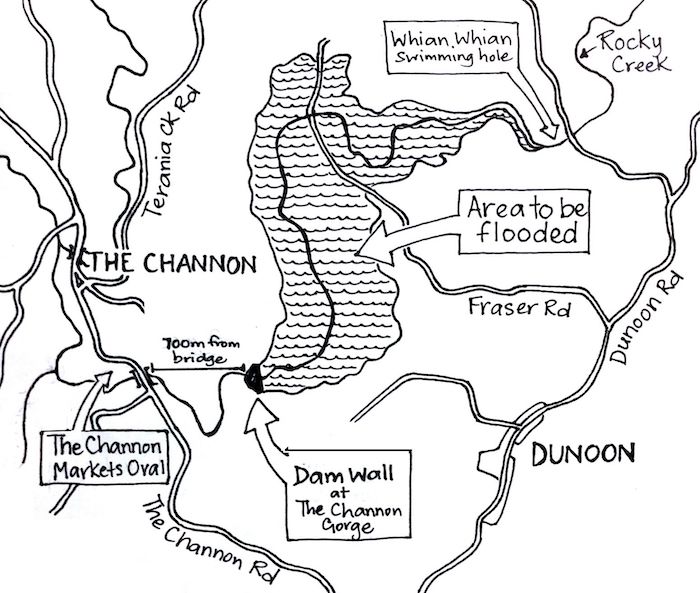
Location of Dunoon Dam proposal
Why a second dam on Rocky Creek is NOT the answer to droughts.
Or floods
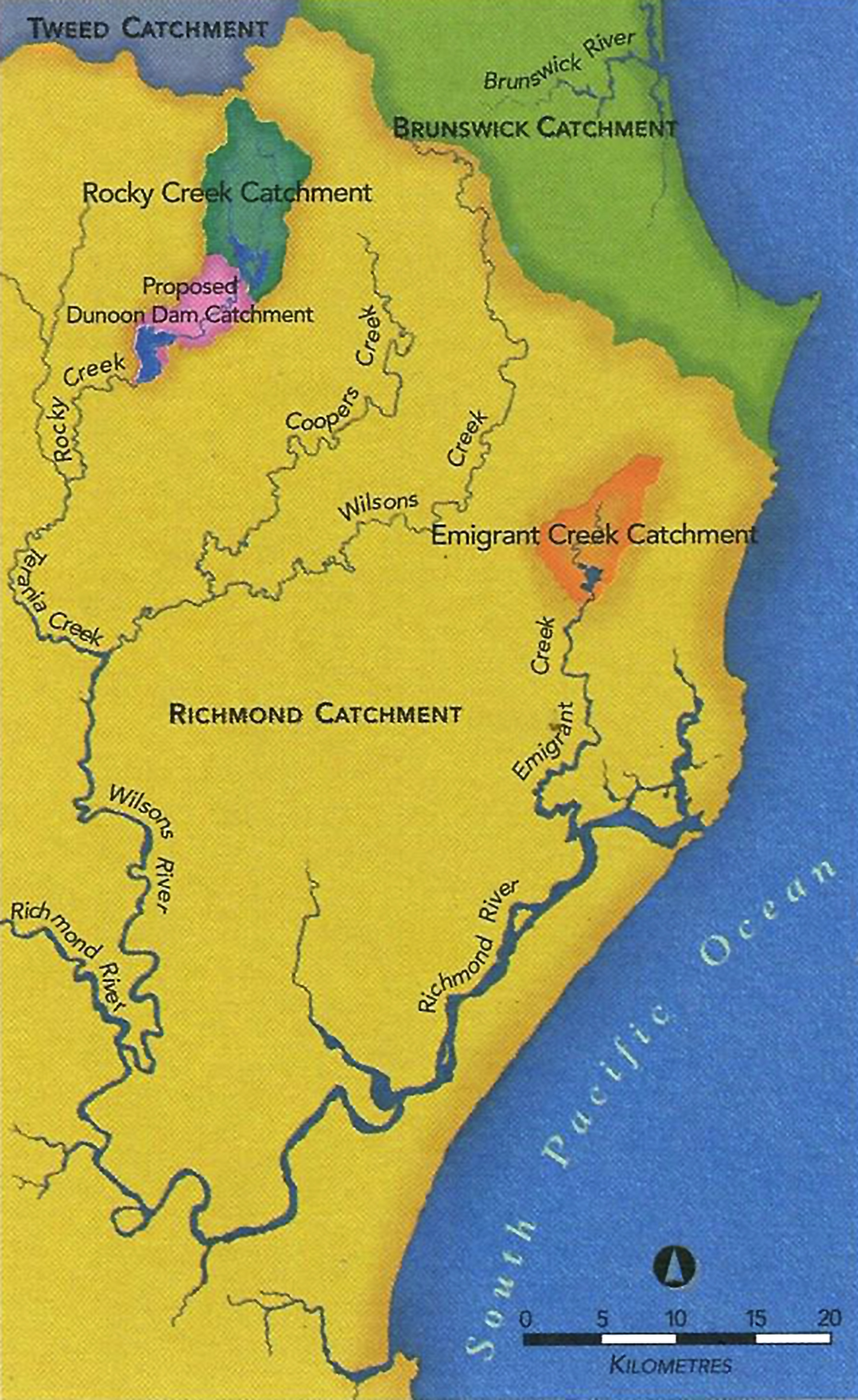
Water Catchment Considerations
The map shows the water catchments of the Rous County Council area.
(Yellow) large catchment area which has potential for rainwater capturing in different ways (urban stormwater harvesting, household tanks etc)
(Dark green) the Rocky Creek Dam catchment, all of it forested and protected, and producing high quality water.
(Pink) the comparatively tiny catchment for the proposed Dunoon Dam. Most of it is farmland of which half is macadamia farms releasing chemicals into the soil runoff.
Why Dunoon Dam would NOT HELP with DROUGHT RESILIENCE
- A second dam would only receive water from the catchment above Rocky Creek Dam when it overspills. But Rocky Creek Dam currently has no provision for overflow and is full only 30% of the time, so a new dam may take years to fill. (Rous does not measure water flows over the spillway).
- Dunoon Dam is 3.5 x the size of Rocky Creek Dam, but has half the catchment size.
- In drought, when overall rainfall decreases, the runoff decreases even more drastically.
- Dunoon Dam’s relatively catchment would deliver very little in a drought.
- Multi-year droughts, predicted with climate change, mean that after a 4.5 year drought we’d have TWO empty dams.

Why Dunoon Dam would NOT help with FLOOD MITIGATION for Lismore?
- The Rocky Creek catchment is only 3.6% of the total catchment of the streams which combine to flood Lismore.
- Even if the two dams were completely empty at the onset of heavy rain the flood mitigation impact would be minimal.
- Most extreme rain events occur during wet periods when dams are already full, in which case they do nothing to hold floodwater back, & can in fact increase severe flood events immediately downstream.
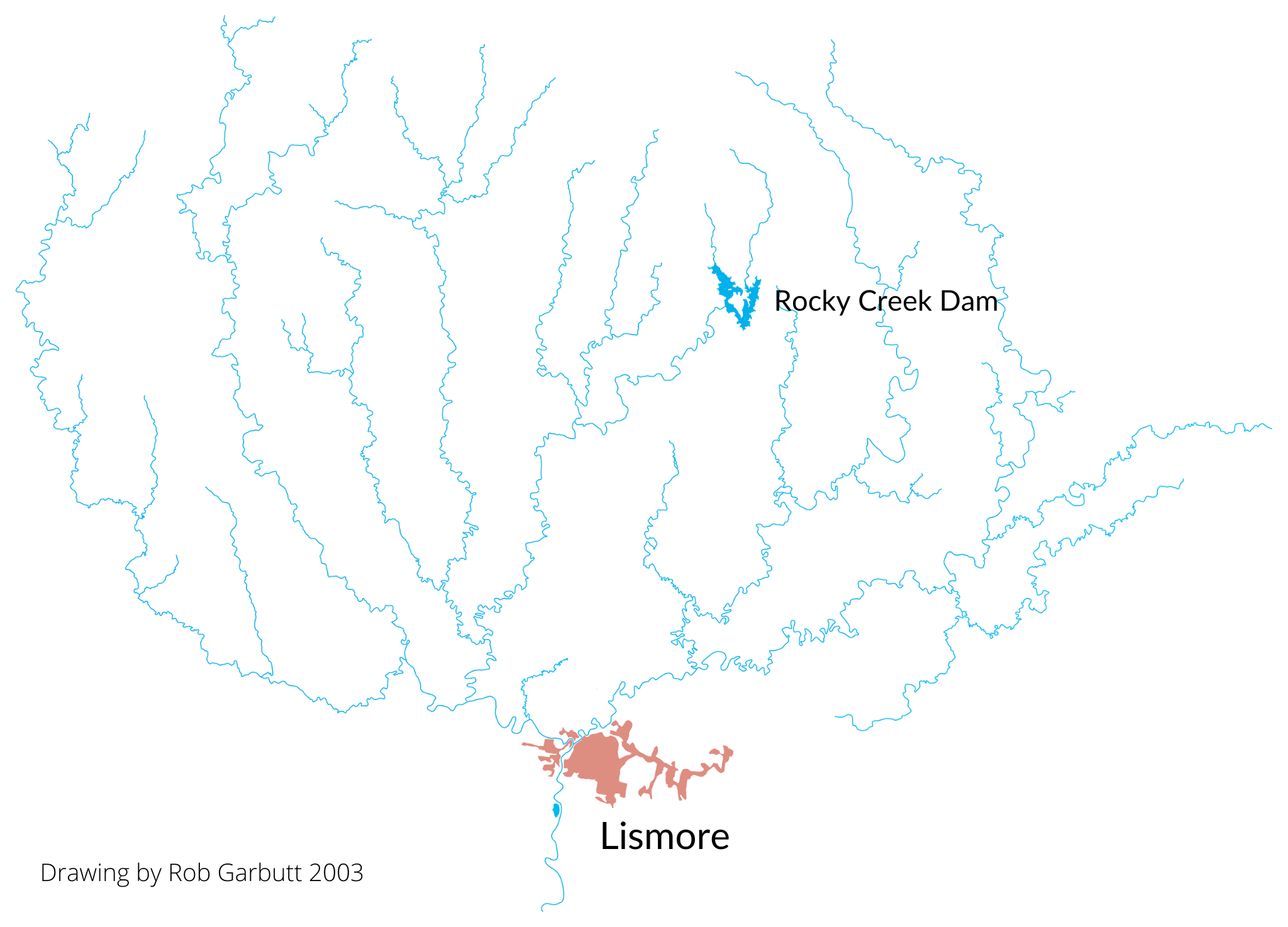
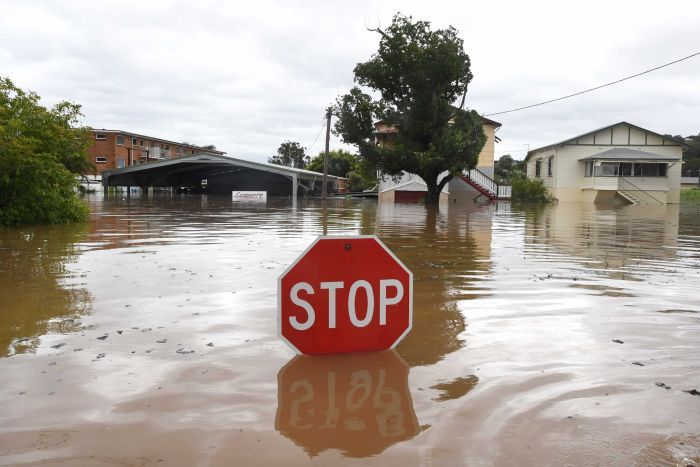
Widjabul Wia-bal elders & youth voice their opposition to the Dunoon Dam,
where their ancestors lie
Watch 4.5min video >>
What is the archaeological significance of the proposed Dunoon dam site?
A Cultural Heritage Impact Assessment was produced in 2011 and updated in 2013 with an additional report on the burial mounds by eminent archeologist Dr Douglas Hobbs. Hobbs recommended ‘that Rous Water establish means to protect the site now that it has been identified and recorded’, confirming the high significance of the Burial Grounds and surrounding area (Hobbs 2013:9). The site is now registered on AHIMS, the NSW Register of Aboriginal Sites.
The redacted Ainsworth Cultural Heritage Impact Assessment (CHIA) Studies have been released.
Ecological impacts of Dunoon Dam site – cannot be offset
Internationally significant ecological remnants are our responsibility
- Only 1% of our region’s Big Scrub rainforest remains. 6.7% is in the proposed dam site & would be destroyed or fragmented.
- These rainforests are part of the Endangered Ecological Community Lowland Rainforest of the NSW North Coast and Sydney Basin Bioregions.
- Water Gums and Grey Myrtles in The Channon Gorge are the largest on record.
- Loss of flora species is cumulative, relentless and ultimately terminal.
- 52 ha of critical koala habitat and corridors would be destroyed, damaged or fragmented.
- Extinction already seriously threatens multiple species including the iconic platypus.
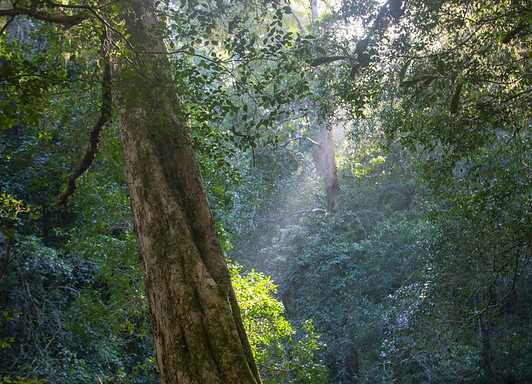
Rare rainforest communities (6.7% of remaining 1% of Big Scrub)
Economic Considerations: Costs, Risks, Jobs & Regional Opportunities
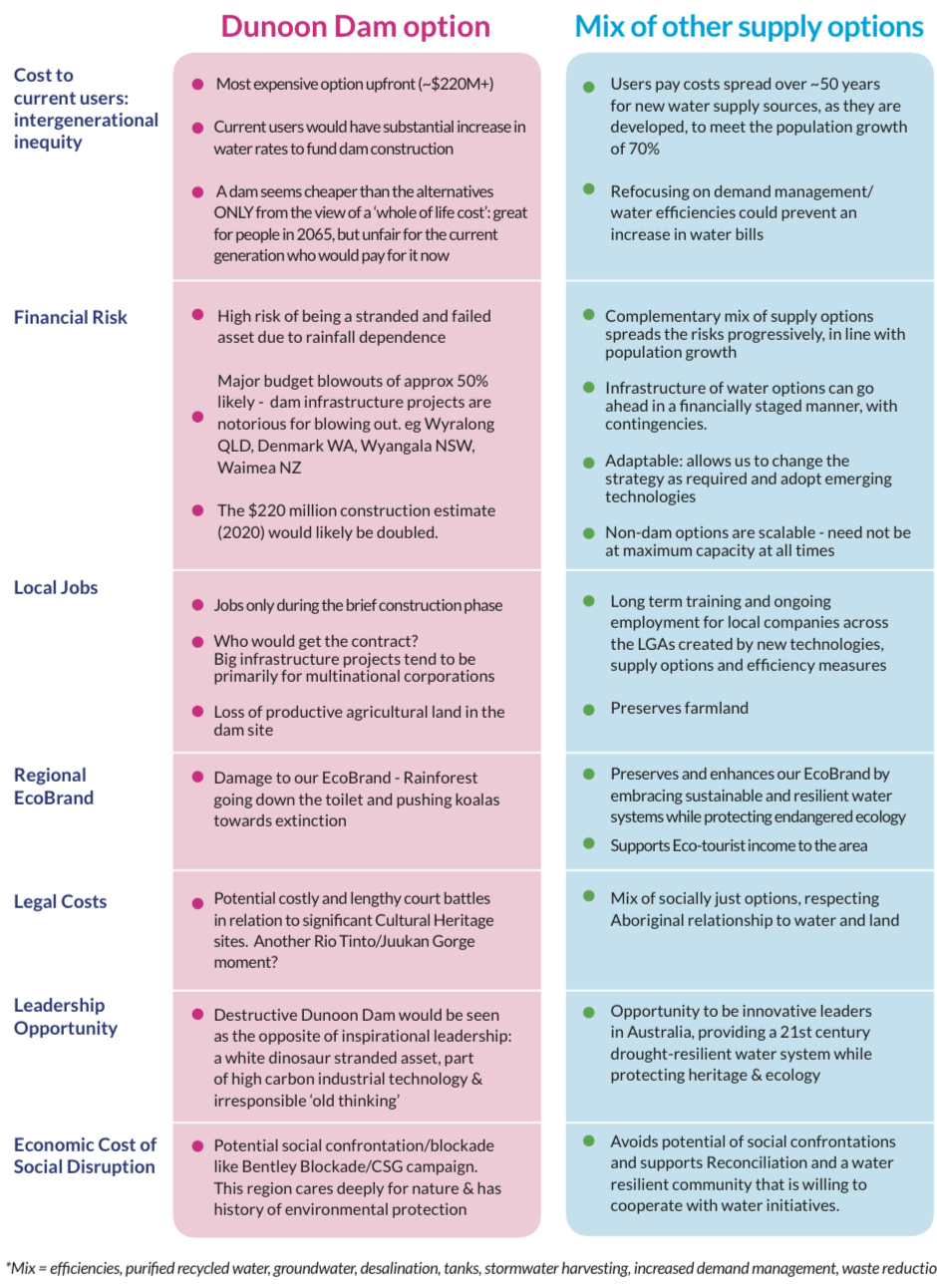
Until we get a 21st century water system, dam plans could re-emerge
This is why we need to continue to work together as a community and with Rous and local governments to see the smart water options roll out, and to counter misinformation and divisiveness.
Remember when, 13 years ago, few people understood renewable energy? Remember how it was misunderstood? That’s where we are with water systems.
We have so much to gain from making the shift to a system with a mix of strategies, so that when the next drought strikes, we have several water options to draw on, instead of sinking all our money into a single catchment of Rocky Creek.
Few things are more important than water security. Will you join us?
Approving water plan against expert recommendations?
Rous County Council appears to be ‘not fit for purpose’
Rous approves ‘shortsighted’ Regional Demand Management Plan (see 4 min vid <<)
Prof. White emphasises, the cheapest and quickest way to obtain the largest amount of water for the supply/demand balance is through water efficiencies, and that the current draft would not have a meaningful impact
His recommendations were:
Despite this, as well as public submissions being critical of plan as it, Rous councillors adopted the plan in full on 19 Oct 2022.
Rous appears committed to not taking an interest in effective water efficiencies and continues to add to the evidence that it cannot do its job and is not fit for purpose.
What does water security really mean?
Water Security comes from a mix of diverse options, both rainfall-independent and rainfall-dependent.
“A diversified water supply portfolio based on rainfall independent supplies offers the opportunity to provide resilience against drought as well as other potential water supply problems.”
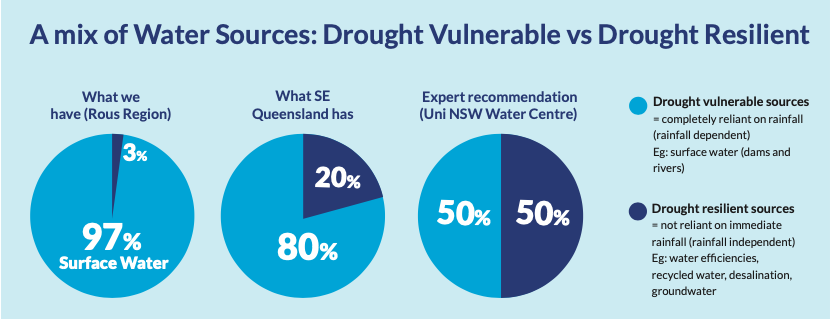
What about dams for water security?
Practically and politically throughout Australia there is a move away from dams as the most secure option. Dams are now considered rainfall dependent/ drought vulnerable. Even a 2nd dam is not drought proof.
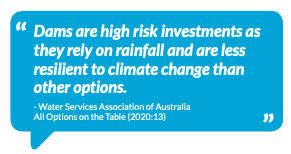
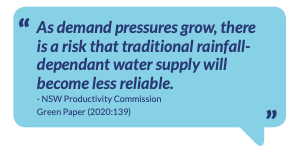
In a warming climate, we need a drought-resilient water system
This is what experts are saying, doing and proving
A complementary mix of options…
In their report All Options on the Table, the Water Services Association of Australia (WSAA) recommends a complementary mix of water options. They caution us that new dams are high-risk investments because they are dependent on rainfall.
Similarly, the 2020 NSW Productivity Commission Green Paper recommends we pursue efficiencies and new supply options such as water recycling.

Prof Stuart White ~ How we might invest in system-wide water efficiency
Watch 9min video by Prof. White on Rous Supply
ISF have been working on integrated water supply and demand planning for over 20 years, including in all mainland States in Australia and in a number of places internationally.
He speaks from this experience and from his personal experience with the Development of the first Rous Regional Demand Management Strategy.
1. Minimise Risk
3. Water Efficiency & Non-potable Reuse
4. A Sustainable & Smart Water Future
Sydney Water did it. Remarkably, they were able to supply an extra 950,000 people, while maintaining water use at levels 25 years before the investment project. Think about that! By optimising water use, close to a million people were accommodated – with no increase in consumption.
Prof Stuart Khan says a drought-resilient system should get 30-50% of its water from rainfall- independent sources, such as water reuse or desalination
Watch 5min video by Prof. Kahn on Rous water supply
Prof Khan: Prof of Civil & Environmental Engineering at UNSW and Member of the Advisory Body to the National Water Grid Authority.
“The Draft NSW Water Plan makes much of the importance of rainfall independent supplies.
I strongly encourage Rous County Council to focus their objectives on water security and resilience. In my opinion another dam constructed on the same waterway, in the same catchment just downstream from the current major water supply, does not progress these outcomes. Instead Rous Council should look for diversification in alternative water catchments and sources.
A diversified water supply portfolio based on rainfall independent supplies offers the opportunity to provide resilience against drought as well as other potential water supply problems”.
David Tomlinson, economist, says on the financial side, the Dunoon dam could become an expensive stranded asset, with current users paying for water that they will never use
Watch 5min video by David Tomlinson on Rous water supply
David Tomlinson: Economist, Writer, local resident & was an elected member of Lismore Council for 9 years.
Elia Hauge, Civil Engineer, speaks on rainfall uncertainty, & the various factors contributing to a resilient water system.
Watch 5min video by Elia Hauge on Rous water supply
Elia Hauge: Civil Engineer, previously working in the Engineering Operations at Sydney Water and currently completing her PhD on Climate Adaptive Planning in the Water Sector.
“Putting all of our reliance on rainfall, especially rainfall from a single catchment, does not provide enough diversity and is not in the best interests of water security for our region.
Elia has strong concerns about what is termed the “expected impact”, which is the suggestion that we can expect a particular future, which does not take into account the predictions of rainfall under climate change and the projected impacts of temperature increases on yield calculations.
In addition, not knowing if there will be a societal behaviour change and the implications for global
warming, leads to further uncertainty around the impacts of climate change and rainfall yield. Elia talks on the video about the impacts of global warming and modelling from a
global model to a regional model.
Now it’s time to shift fully to Diverse Water Options
Regulated Deep Groundwater
Tapping long-cycle water, reliable even during times of drought
Confused about the Alstonville Aquifer?
This diagram explains what Rous plans for the Alstonville aquifer. This strategy is in the plan with or without Dunoon Dam, due to time pressures of demand exceeding supply by 2024.
- Rous is going to pull their current urban water supply bore out of the shallow Alstonville aquifer.
- Rous will put a new urban water supply bore in the much deeper and larger Clarence-Moreton Basin.
- Rous will take only 1.2 GL per year, and only to supply the Alstonville Wollongbar area.
- This will leave more water for the farmers who currently have bores in the upper aquifer. They use about 8 GL per year but the bores are unmetered so the amount is not known exactly.
- This is not “water-mining” or “draining the aquifer”
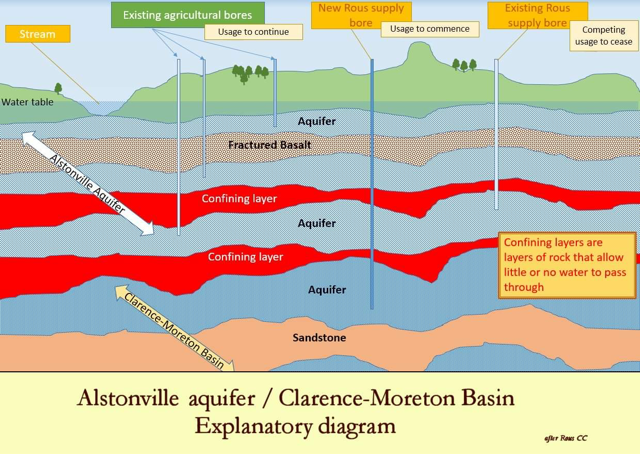
Did you know? The deep aquifer below Alstonville would only supply the Alstonville Wollongbar area?
System-wide water efficiency
Creates local jobs, saves money, saves water
- Efficiency includes fixing leaks, replacing inefficient appliances, effective monitoring of usage, and community education programs
- Prof. Stuart. White, one of Australia’s foremost experts in water efficiency programs, estimates Rous Water could save 3,344 megalitres p.a. (ML/a) by 2030 through system-wide water efficiencies alone.
- His report suggests we could meet our supply needs up to 2044 for approx. 1/9th of the cost of the proposed Dunoon Dam. That’s without the need for a dam or groundwater.
- Regional cooperation – there will need to be a Rous region-wide commitment from all constituent councils and local water utilities to decreasing wattage in the system, and to value every drop of water
- Local example: In the Rous system, 15-18% of water is lost before it reaches houses.

Did you know? System-wide water efficiency is about reclaiming otherwise wasted water: “A permanent reduction in waste is a permanent increase in supply” (Prof. White)
Purified Recycled Water
Capturing water in the system for re-use
- Recycled water is a reliable, safe and sustainable alternative to help conserve our precious drinking water. It is a drought proof water source with no restrictions during droughts.
- NSW Health supports the use of recycled water reuse and has established standards and guidelines for its usage.
- Regulators require this water to be treated and tested to a much higher standard than regular tap water. “The recycled water that currently comes out of the purple pipe in Ballina is far, far cleaner than the water we could extract from the dam at Emigrant Creek or anywhere else” Rous County Council Chair Keith Williams, 2021
- Approximately 70% of the water in our homes could be replaced with recycled water (Byron Council website)
- Local examples: Perradenya Estate at Caniaba, Lismore offers a Pilot Plant that complies with Australian Drinking Water Quality guidelines. It could be the 1st Pilot in NSW to use the technology and have it licensed, and put us on the map for innovative water solutions.
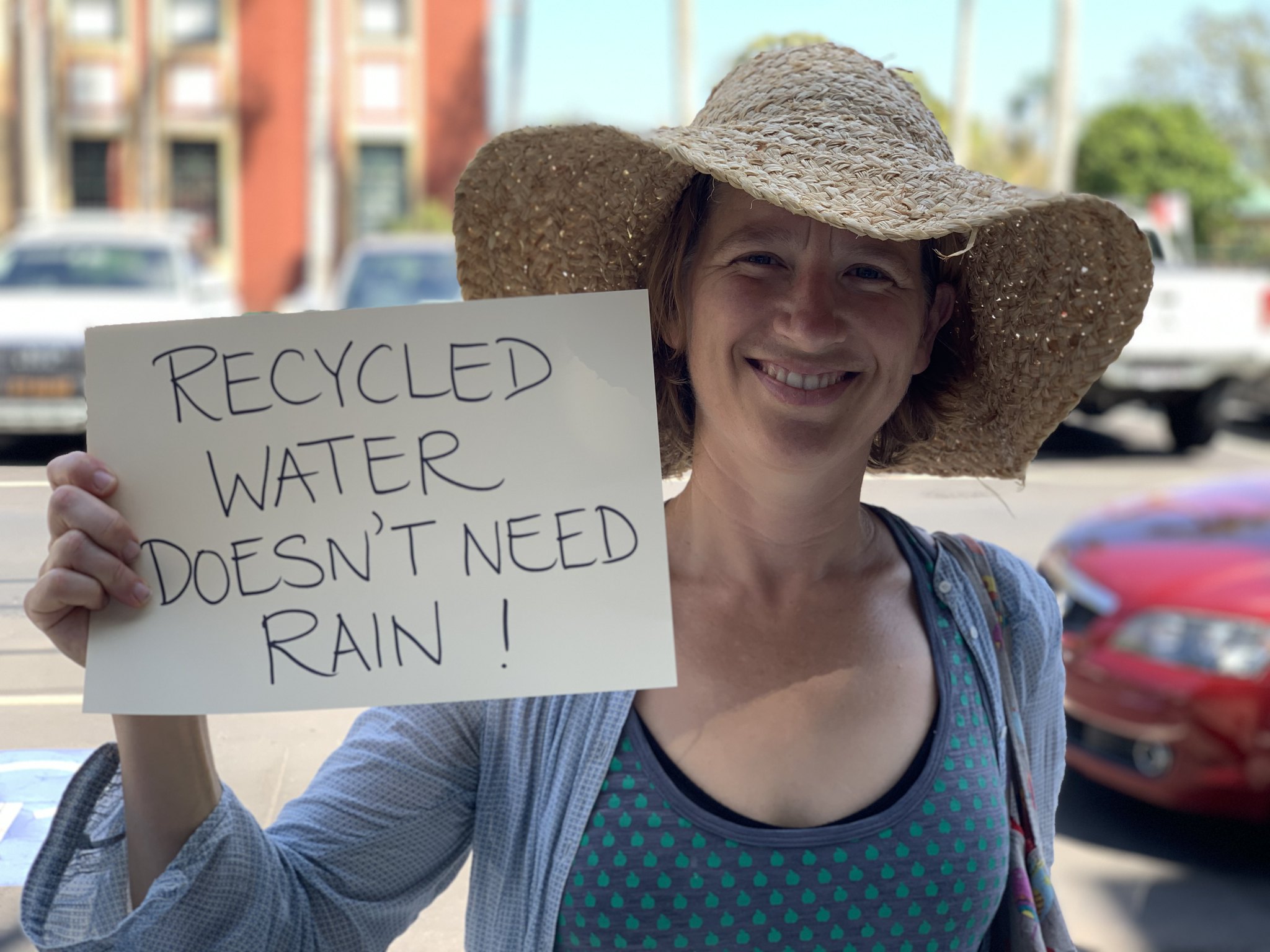
Did you know? In Ballina, purple pipes with recycled water are in current use for new houses.
Renewable-powered desalination
rainfall-independent on-demand scalable supply
- While energy intensive, plants can be powered by renewable energy.
- The Gold Coast desalination plant has a pipeline that takes brine 1.5km offshore. In this best-case scenario, an artificial reef has formed around the outfall infrastructure.
- WA example: Perth’s water supply in 2019-20 was 43% from desalination plants.
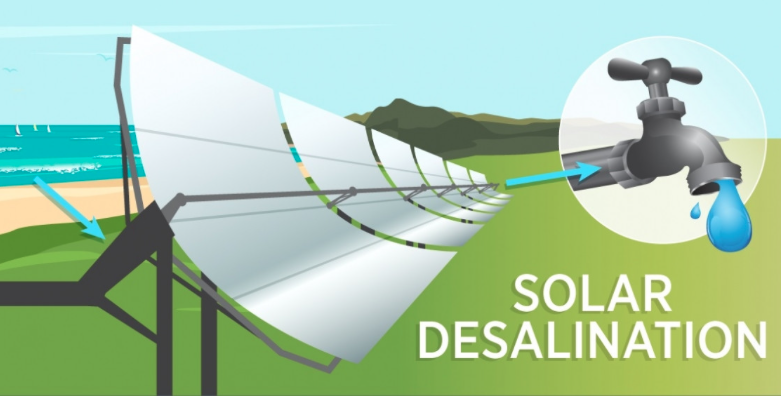
Did you know? Rous’ IWCM plan has a “Temporary Desal Plant” for potential safeguarding in the event of a drought emergency.
Water harvesting that is otherwise lost in run-off
Stormwater harvesting
- 1st large scale project in NSW for indirect-to-potable stormwater harvesting approx 1300 ML water p.a. into Orange’s raw water supply
- Provides 25% of Orange’s total water needs
Rainwater Tanks
- More drought resilient than dams because they can re-fill from passing showers which don’t provide runoff for dams.
- Tanks promote a culture of household water conservation
- Increased subsidies & rebates for tanks in our region would increase uptake
Roof water harvesting
- ‘taps’ a new water catchment: roof water from new estates
- Example: Warrnambool’s Roof Water Harvesting Tool Kit assists growth regions.
- Warrnambool harvests 720ml. BALLINA GETS 1800ml.
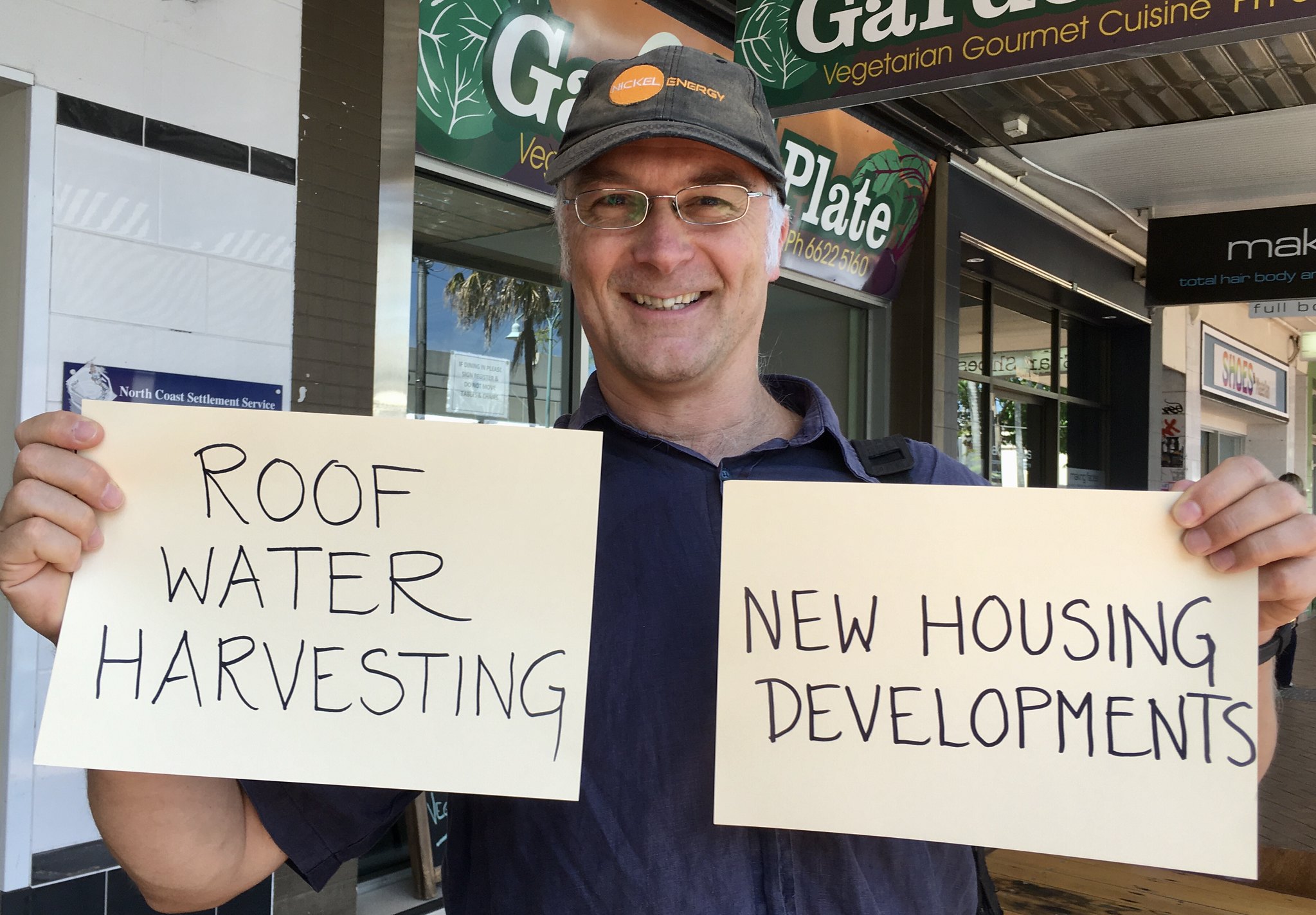
Did you know? Stormwater Harvesting = 25% of total water needs in Orange
WHO ARE WE ?
WATER Northern Rivers is a non-politically aligned alliance of citizens and groups who want a complementary mix of modern water options, which does not include the destructive Dunoon Dam. We are committed to a water system fit for the 21st century, one we can be proud of.

